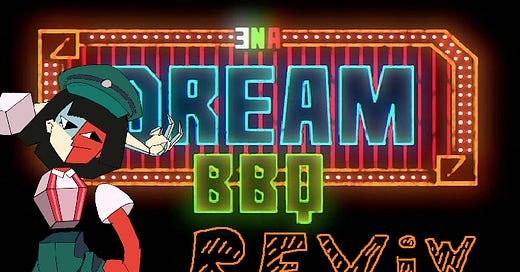I feel it’s very important for this review to start with some required reading.
Watch this video to see the opening to the game:
I’ve never been so confused by a game.
Correction.
I’ve never been so confused by a game, and yet been so delighted.
ENA: Dream BBQ is a shining example of games as art. The game is visually stunning, and unique.
Its game worlds are lush with references to LSD Dream Emulator, Zelda CDI, and other late ‘90s iconography from the internet and games.
ENA: Dream BBQ also showcases a hefty amount of mixed media, which I am a huge fan of. It exudes such a high level of quality and love for games, the internet, and digital media as a whole. The lavishly decorated main menu had me awestruck from the moment I saw it.
What I’m trying to convey is the immense amount of effort poured into the game by it’s developers and art directors.
I believe that everything the game does is intentional. Its avant-garde nature allows it to stand out as art — something so many games struggle to do (or at least realize they are doing).
If the visuals feel like a collage of digital magazine clippings from the ‘90s. The dialogue is what would happen if you tried telling a story by cutting each character’s lines out from different books. A story could be gleaned from the clippings, but I get the strange feeling each of the characters is talking to one another from different universes.
I’ll give an example:
I’m sure you can see for yourself how there’s something… off-putting about the dialogue. There’s just such a high level of effort and intentionality put into the style of every character and the different mediums they are expressed through. Even the language they use is chosen for the archetype they represent. Some characters speak English, others speak Japanese, and languages like Russian and Italian also show up.
This primarily is why the game works as an art piece. I have an interpretation of what it all means, but it’s not explicitly described. To me it feels like a game where a collage of late-’90s digital entities must speak to each other through their own digital lenses.
Microsoft Paint characters are cartoony and wacky. Japanese characters feel mysterious and feel poorly translated. Others speak in voice grunting—an old school gaming technique where characters communicate through grunts while text is written below to save on memory space (see Banjo Kazooie/Banjo Tooie).
The game is a collage of time period references, but it’s not random. ENA is a character created YouTuber Joel G, who’s been making ENA shorts for about four years now.
Regardless of whether you enjoy the experience, it’s impossible to disregard how true the game stays to its animated shorts. It includes many references to previous works, and retains the surreal style the ENA shorts are known for.
The fact that ENA’s latest outing is a game seems fitting. The animated episodes already use a “game cutscene” framing device, so I’m glad to see it fully realized.
I recommend you give ENA: Dream BBQ a shot. The game is releasing in episodes, and the first episode is free on Steam:
ENA: Dream BBQ surreal indie games art games mixed media games 90s retro games Walking Simulator Indie Game Joel G ENA episodic games avant-garde gaming LSD Dream Emulator Zelda CDI surreal dialogue multilingual characters free Steam games collage art style surrealism in gaming retro internet culture experimental game design






HAHA, are you kidding? I hate this stupid job.